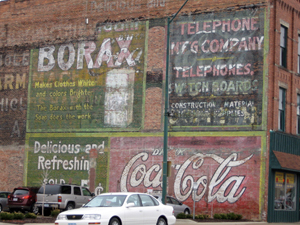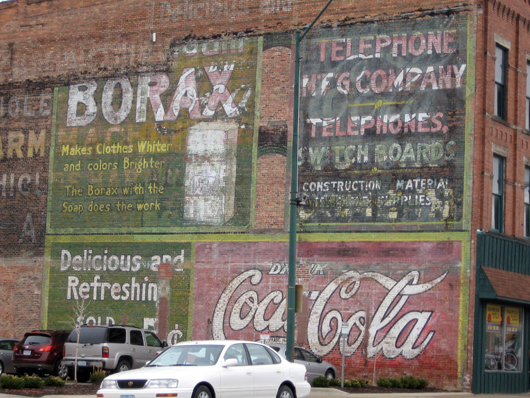
PITTSBURGH (AP) – At Maurice “Red” O’Donnell’s three-story house in Homewood, Pa., the phone rang constantly with calls from customers.
That trilling telephone meant income for the blue-eyed, red-haired father of eight whose third-grade education, confidence and ability to paint outdoor signs on the sides of large buildings kept him in business for more than 25 years.
Between the 1930s and 1950s, he painted signs for such clients as Dad’s Root Beer, Meadow Gold Ice Cream and Borden’s Milk all over western Pennsylvania.
“He was self-employed. He worked morning, noon and night,” says his daughter Marge McMackin, a retired high school English and journalism teacher who lives in Garfield, Pa.
The son of Irish immigrants, the late sign painter belonged to a fraternity of brush-wielding, overalls-wearing men called “wall dogs” who created an idiosyncratic form of commercial art that promoted beer, bread, cigars, flour, well-tailored clothes, soda pop and any other product or service someone wanted to sell.
Many of these large signs are still visible in Pittsburgh and other Midwestern and mid-Atlantic cities partly because they were often applied to brick walls with lead-based paint. Some are revealed in vivid color when old buildings are torn down, which is how Polish Hill got its Mother’s Bread sign back in 2008. Several years ago, a Star Soap ad on Penn Avenue in Garfield was restored by artist Jocelyn Jacobs through a seed grant from the Sprout Fund.
Often called ghost signs because they are fading and have been painted over older ads, this slice of roadside culture is the subject of several books, web sites, at least two documentaries and innumerable postings on flicker.com.
Earlier this year, William Stage, a Missouri journalist in St. Louis, launched a web site, www.paintedad.com, to archive and showcase images of these signs he began photographing 35 years ago. He’s turned his favorites into a book of color postcards called The Painted Ad that can be torn out and sent or kept as mementos. His first book on the subject, Ghost Signs: Brick Wall Signs in America, appeared in 1989.
Some of the ad copy from these old signs, Stage says, is so naive that it’s endearing. Examples he has captured in St. Louis include, “Waverly Bicycles will drive your cares away” and “Every puff a pleasure.”
When O’Donnell painted a sign in Pittsburgh, he left a red oval at the top, a personal signature derived from his red hair, plus his surname. A tagline on his business stationery advised, “Look at your sign … everyone else does!”
A Dad’s Root Beer sign he painted is still visible on the side of a three-story brick building at 1816 N. Charles St., just above the North Side intersection of Brighton Road, California Avenue and McCullough Street. O’Donnell painted the sign with the help of his eldest son, Maurice “Butch” O’Donnell, an electrician who lives on the North Side.
Available light dictated how long painters could work, so the O’Donnell family’s paterfamilias rose early.
“He was gone by 7:30 a.m.,” McMackin says.
At day’s end, he joined his family for dinner in a canary yellow kitchen at a yellow rectangular table he built and trimmed in wood. Besides the eight children, he dined with his wife, Margaret Mary Kress, a religious woman, and his mother-in-law, Anna, a seamstress who lived with the family and earned an income working for a dry cleaner.
Before setting out, O’Donnell worked in the basement of his home at 711 Collier St. On a large drafting table, he used pencil and chalk to sketch designs on brown paper. Using a perforation wheel, he pierced holes in the paper, creating what wall dogs called a “pounce pattern” and carried it with him to a job.
To paint, O’Donnell installed gigantic hooks at the top of a building, from which ropes hung. Those ropes held “stages,” 8-foot-long, foot-and-a-half-wide wooden planks on which he stood while he painted. He raised and lowered himself with hand-cranked pulleys.
O’Donnell took the paper tracings and applied them in sections to a building’s exterior. Then, he took a makeshift cloth bag filled with powdered chalk and pounded the substance through the paper, transferring the chalk design to the wall. And that was just the beginning of hours spent in the heat, humidity and sometimes harsh weather and strong winds.
O’Donnell was a child when his father died, but he was a constant learner. The Reader’s Digest stayed on the bathroom commode; in that spot he kept lists of new vocabulary words to learn. His favorite was “indubitably.”
McMackin was 12 when her father began commissioning her to make signs for local businesses, such as Herman’s Men’s Shop in Homewood. Had she been a son, she might have inherited her father’s business. Instead she carried her artistic ability throughout a 24-year teaching career.
At age 17, she took a job at Century Printing in Homewood, where she learned graphic design and also met her husband, Michael McMackin. That income paid for her sister, Cathy Muha, to attend a local nursing school and her brother, Tom, to attend St. Pius X Seminary in Covington, Ky., although he became an electrician instead of a Catholic priest.
McMackin kept the books for her father’s business but left printing for teaching and earned a doctorate in education. She still consults for the University of Pittsburgh on ways to improve education in underachieving public school districts.
In the late 1950s, the O’Donnells moved to a property on Laketon Road in Wilkinsburg with a larger home and a three-car garage. That essential amenity allowed O’Donnell to stow two trucks for his business. Above that large garage was a room that became his new work space. He died in 1964 at age 55.
Jennifer Baron, 41, a writer for Pop City Media, traces her love of distinctive signage to the days when her family took trips to visit relatives, traveling on Route 51, Route 30 and the Pennsylvania Turnpike. Baron, who lives in Dormont, Pa., loves the Main Street quality of neon and hand-painted signs. They are, she says, more human in scale and, therefore, far more evocative than the sterile giant logos that top so many Downtown buildings in Pittsburgh.
She collaborated with Greg Langel, Elizabeth Perry and Mark Stroup to photograph well-known and obscure signs for a book titled Pittsburgh Signs Project. Published in 2009 by Carnegie Mellon University Press, the soft-bound volume features a cleverly designed cover by Brett Yasko and 250 images inside. While many of the signs are neon, some were hand-painted by wall dogs. You can see these images at www.pittsburghsigns.org.
Baron, who writes a monthly column for the Western Pennsylvania History Magazine, is especially fond of the 30-foot- by-60-foot hand-painted Mother’s Bread sign on the side of a clapboard house at 3209 Dobson St. in Polish Hill. The sign emerged after a fire destroyed an adjacent three-story brick duplex in 2008 and the building was torn down.
Jim Young bought the clapboard house in 2004, loves the Mother’s Bread sign and wants to preserve it. The vacant lot next door to his home is under private ownership.
“It’s nice to have that sight line open,” says Leslie Clague, a staff member of the Polish Hill Civic Association, adding that the sign attracts photographers. Local musician Eric Vermillion and members of his rock band, Food, recently had their photograph taken in front of the Mother’s Bread sign and will use the picture on a new recording.
Baron hopes her next road trip will be to Cincinnati to visit the American Sign Museum, which opened in 2005 to educate the public about the history of the sign industry.
Once you start noticing ghost signs, they can become an obsession, she says.
Recently, she documented the destruction of the South Hills Theater in Dormont, which was leveled, along with two Victorian houses and a hillside, to make way for a CVS.
During construction, Baron found a ghost sign that advertised parking for $1 in bright red and white paint. Now that the CVS is up, the sign is gone.
“It was this bright flash of color with this bright red and white paint. It had been incredibly well preserved because it was between two buildings,” she says.
“What really struck me was how I was watching history being revealed and torn down at the same time.”
___
Online:
http://bit.ly/tYRxi2
Copyright 2011 Associated Press. All rights reserved. This material may not be published, broadcast, rewritten, or redistributed.
AP-WF-12-04-11 2251GMT
ADDITIONAL IMAGE OF NOTE


